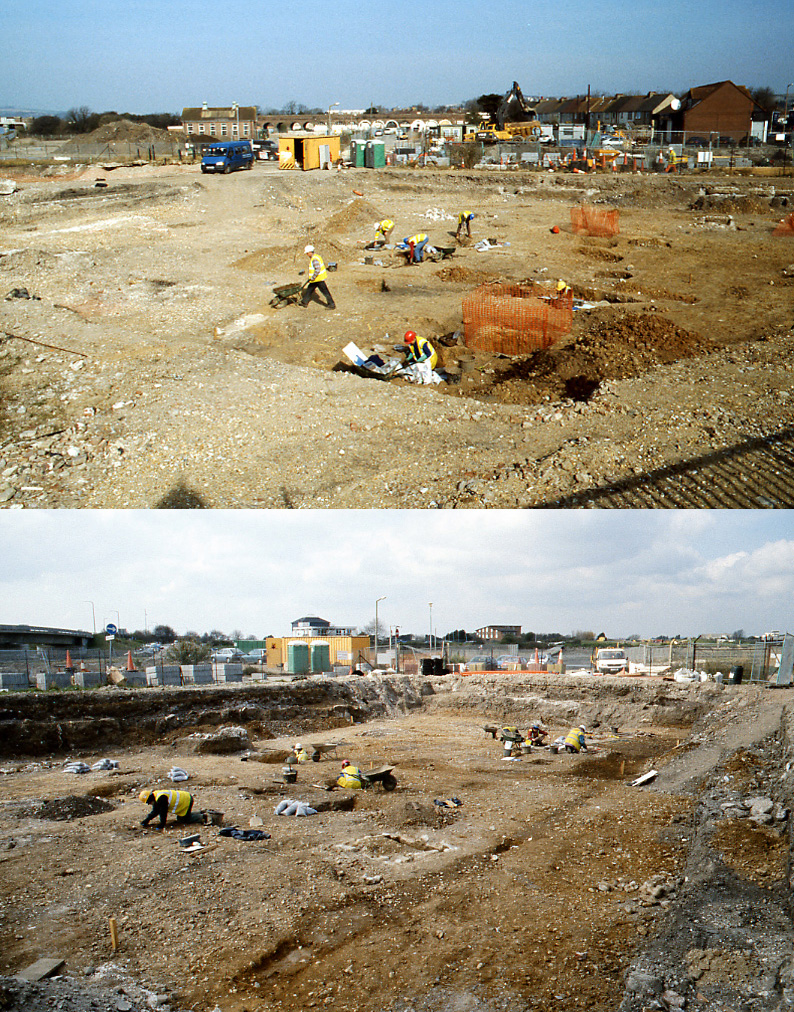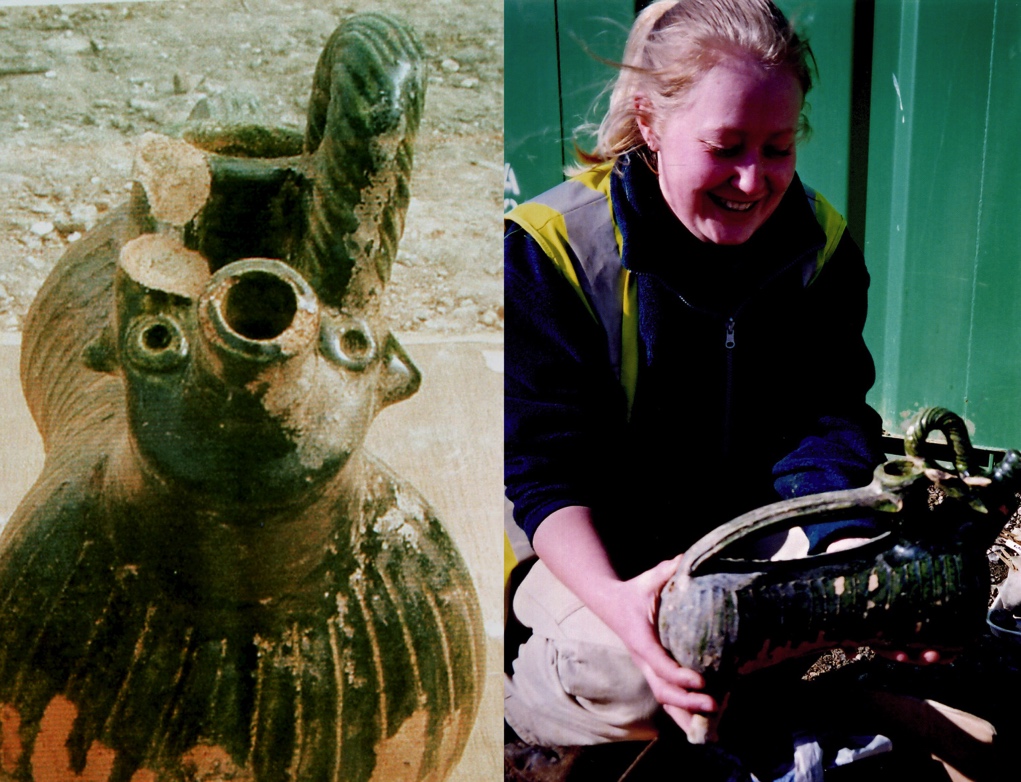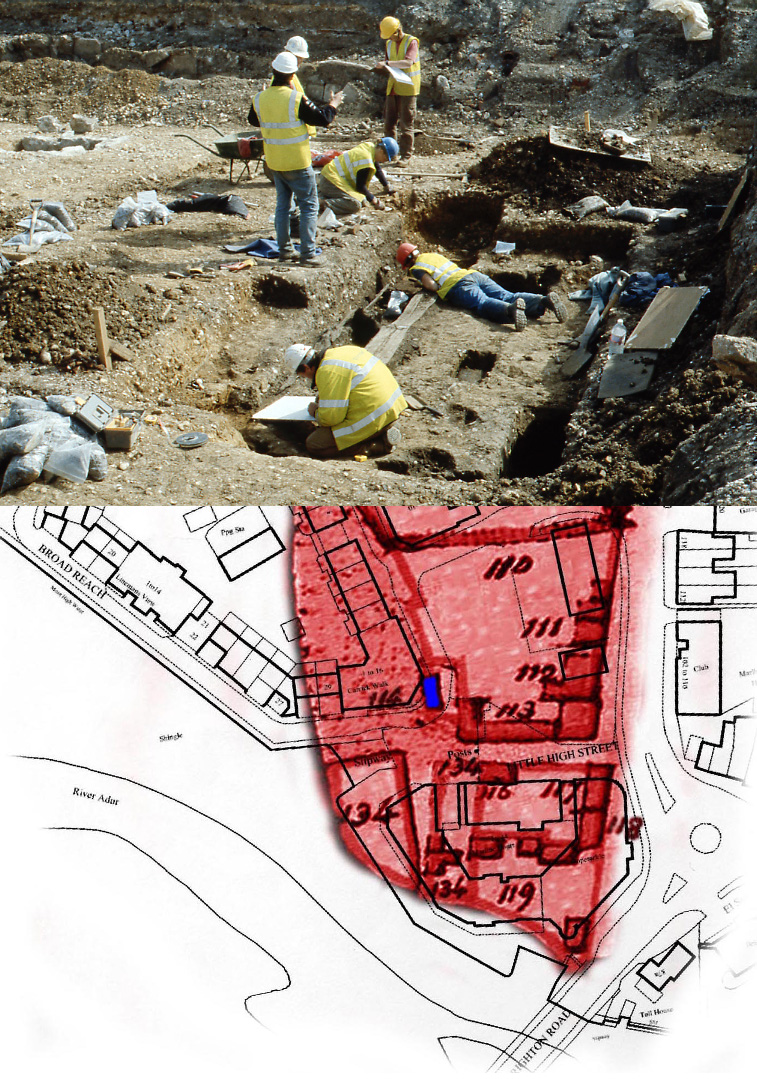Introduction
The Ropetackle site had been the subject of a long-running series of failed development plans, but following the entry of SEEDA (South East England Development Agency) into the process planning, permission was given for a mixed development at the site. Owing to the position of the site within the area of the well-documented Norman new town and busy medieval port, and hence the high potential for the survival of archaeological remains, a condition was attached to the planning permission requiring archaeological work in advance of any development. Hence an archaeological evaluation was carried out in October 2000. The excavation of trial trenches uncovered a number of medieval and post-medieval remains with associated assemblages of pottery, animal bone, building material, clay tobacco pipes and other artefacts. These results confirmed the significance of the site, and underlined the need for more archaeological work.

Detailed large-scale excavation and recording at the site began in January 2003 in advance of the much-heralded development and continued until the end of May of that year. Following the mechanical removal of deep deposits of modern material, two large areas either side of the old alignment of Little High Street were investigated. A range of archaeological features were discovered including post-holes, ditches, gullies, wells, and numerous rubbish pits and cess-pits, as well as limited evidence of building activity. Dating of the recovered pottery and other artefacts showed that the site had seen activity from prehistoric times until the present day.
Prehistoric and Romano-British Remains
A background scatter of struck flint and fire-cracked flint recovered from later deposits suggests some prehistoric activity in the vicinity. One potentially Late Bronze Age pit was also uncovered, but it contained only one tiny sherd of pottery. However, there was undeniable evidence of Late Iron Age/Romano-British activity at the site, with a ditch and a number of small pits containing sherds of Late Iron Age/Romano-British pottery, concentrated to the north of Little High Street. Residual pottery from the period was also found in a number of later features.
Results from numerous excavations on the West Sussex Coastal Plain to the west of Shoreham, in areas such as Durrington, Angmering, Bognor and Littlehampton suggest that this part of the county was relatively densely populated in the prehistoric period. There are also a number of known findspots of prehistoric material in the Adur area. The fertility of the local soils was undoubtedly a factor in this. The popularity continued into the Romano-British era, when the coastal area was again popular, with a number of villas and other sites located between the Downs and the sea (including a particularly large villa in Southwick).
Medieval Remains
The vast majority of the excavated features at Ropetackle dated from the medieval period with large assemblages of pottery recovered from deep rubbish pits and cess-pits. Significant quantities of animal and fish bone were also retrieved, in addition to shell, metalwork, building materials (including an interesting group of chimney pots), and a variety of small finds, including a number of well-preserved buckles. The vast majority of the material dates from the 13th and 14th century, although some earlier material dating from shortly after the Norman Conquest and the foundation of the town was also recovered. Material recovered from the medieval cess-pits included intestinal parasite eggs, showing that the inhabitants of Shoreham suffered infestation from whipworms and roundworms.
The animal bone recovered from the site was from numerous different species, predominantly from meat-bearing animals such as cattle, sheep, pigs (and arguably horses), as well as chickens and geese. Bones from domestic animals such as cats and dogs were also identified. There was also a sizeable collection of bird bones from species such as gulls, ducks and pigeons, all three of which are known to have been eaten in medieval times.
Also of particular interest was a large collection of artefacts and well-preserved environmental evidence from a well located to the south of Little High Street. The impressive pottery assemblage including an almost complete aquamanile, (a type of water jug used for hand washing before meals), only the third known example of a complete artefact of this kind to be found in Sussex (the others were found in Lewes and Seaford). The green-glazed jug was in the shape of a ram, complete with face, eyes, horns, legs, body and a tail. One of the legs had been snapped off in antiquity, but was recovered from further down in the well itself, leaving the jug complete except for part of one of the horns. Analysis suggests a 13th to 14th century date and the place of manufacture as Scarborough, a known centre for this type of highly decorated pottery. The piece is currently on display in the Marlipins Museum, appropriately close to where it was found. Curiously, the Metropolitan Museum of Art in New York has a similar aquamanile housed in its collection.

A small number of other near-complete medieval vessels were found including fine green-glazed jugs, (including French imports) and coarser cooking pots and storage jars discarded into rubbish pits. Heavier domestic objects such as quernstones (including imported German lava examples) and pieces of at least one stone mortar were also recovered. Other items reflect Shoreham’s status as an important medieval port, such as fish hooks, stone anchor weights and bone needles for sewing nets.
Post-Medieval Remains
The site produced a range of post-medieval remains including large assemblages of pottery, a particularly eye-catching collection of clay pipes and other artefacts recovered from wells, pits and a row of privies located in the former back yards of houses fronting onto the north side of Little High Street. An unexpected bonus was the presence of reused finely-worked medieval masonry in one of these structures. The pottery and clay pipe assemblages span the 17th, 18th and 19th centuries, and include a fascinating range of ceramics including imported pottery from as far away as China. Other exotic post-medieval finds included a cowrie shell from the Red Sea/Gulf of Aden area.
The surviving remains of a number of demolished post-medieval buildings were also recorded on both sides of the road, including remains of the King’s Head, demolished in the 1980s. Numerous clay tobacco pipes and glassware were found in pits in the vicinity, clear evidence of the site of a long-lived Public House. Away from the street frontage, a buried timber structure provisionally identified as a saw pit was excavated and recorded. Study of early maps of the area confirmed this identification, with a structure labelled ‘saw pit’ clearly visible on a map dating from 1780s. Other post-medieval remains included the reinforced concrete walls of a large World War II air raid shelter and part of a contemporary gas mask.

Post-Excavation Work
A programme of post-excavation analysis has been undertaken, leading to the eventual publication of the site in the near future. Particular attention was paid to the huge assemblage of pottery from the site (more than 18,000 sherds were recovered during the evaluation and excavation phases combined), and on the unusually fine group of clay pipes, as well as to the fine collection of animal and fish bone and other artefacts and environmental evidence such as charcoal and charred seed grains of wheat, barley and other cereals. The fish bone assemblage has been acknowledged as one of the finest from the south-east of England and includes numerous species of both sea and fresh water fish.
More Work at the Site
Further archaeological excavations have recently been undertaken at the site by Thames Valley Archaeological Services in the area of the site formerly occupied by the SAAB Garage.

Simon Stevens
Senior Archaeologist for
Archaeology South East
January 2010
Photos/Maps Simon Stevens and Roger Bateman


I was born in 31 West Street in 1926 and lived there until the 1950s. Since I left, I have been back two or three times but have otherwise had little contact. Now at the age of 93 I have been looking back and remembering life at that time. Strangely enough, I once met two Shoreham residents when holidaying on the Greek island of Kos, which I now visit two or three times a year. They kindly sent me photos of West Street as it is now and that reawakened my interest. It took me a while but I finally decided that I would like to explore a bit further. Any useful leads would me much appreciated.
Lovely to hear from you John. Have you read Gerry White’s reminiscences on this website as it includes some of his memories of West Street? http://www.shorehambysea.com/memories-shoreham-sea/
As you say our street directories record your family at 31 West Street from 1925 onwards – before that there was a Mrs Challen at number 33.
Nelson (Roger Bateman)